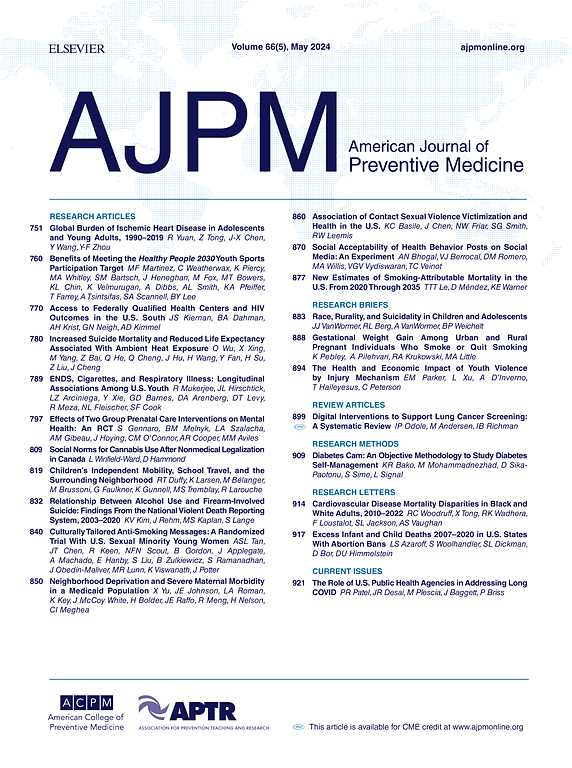Radon Mitigation in Native Communities: A Partnership Between a Tribal Health Clinic and University of Wisconsin Carbone Cancer Center to Reduce Carcinogen Exposure
IF 4.5
2区 医学
Q1 MEDICINE, GENERAL & INTERNAL
引用次数: 0
Abstract
Introduction
Radon exposure is the second leading cause of lung cancer in the U.S. and has a synergistic effect with tobacco smoke. Lung cancer has a high incidence among Native American communities in Wisconsin. This project aimed to assess and mitigate radon exposure in Native American homes on the Stockbridge-Munsee reservation.
Methods
In collaboration with the Stockbridge-Munsee Mohican Tribe, 83 radon test kits were distributed, and radon exposure data were collected from this Tribal community between April 2023 and September 2024.
Results
Of the 83 homes tested in the Tribal community, 56 (67.5%) exceeded the recommended radon exposure level and underwent radon mitigation. Among those with elevated radon levels, the median concentration was 10.1 picocuries per liter (pCi/L), with values ranging from 4 to 111.6 pCi/L. High radon levels were detected in both warm and cold months and in homes with varying foundation types.
Conclusions
Radon levels on Tribal lands were higher than anticipated, which may contribute to the increased incidence of lung cancer in Native communities. This initiative underscores the need for radon testing and mitigation in Tribal communities to address environmental health disparities and improve health.
减少土著社区的氡:部落保健诊所和华盛顿大学碳癌症中心之间的伙伴关系,以减少致癌物暴露。
在美国,氡暴露是导致肺癌的第二大原因,并与烟草烟雾产生协同效应。肺癌在威斯康辛州的印第安人社区中发病率很高。该项目旨在评估和减少斯托克布里奇-蒙西保留地美洲原住民家庭的氡暴露。方法:与Stockbridge-Munsee Mohican部落合作,于2023年4月至2024年9月在该部落社区分发了83个氡检测试剂盒,并收集了氡暴露数据。结果:在部落社区测试的83个家庭中,56个(67.5%)超过了建议的氡暴露水平,并接受了氡缓解。在氡水平升高的人群中,浓度中位数为10.1 pCi/L,范围为4 ~ 111.6 pCi/L。在温暖和寒冷的月份以及不同地基类型的家庭中都检测到高氡水平。结论:部落土地上的氡水平高于预期,这可能导致土著社区肺癌发病率增加。这一举措强调需要在部落社区进行氡检测和减少,以解决环境健康差异和改善健康。
本文章由计算机程序翻译,如有差异,请以英文原文为准。
求助全文
约1分钟内获得全文
求助全文
来源期刊

American Journal of Preventive Medicine
医学-公共卫生、环境卫生与职业卫生
CiteScore
8.60
自引率
1.80%
发文量
395
审稿时长
32 days
期刊介绍:
The American Journal of Preventive Medicine is the official journal of the American College of Preventive Medicine and the Association for Prevention Teaching and Research. It publishes articles in the areas of prevention research, teaching, practice and policy. Original research is published on interventions aimed at the prevention of chronic and acute disease and the promotion of individual and community health.
Of particular emphasis are papers that address the primary and secondary prevention of important clinical, behavioral and public health issues such as injury and violence, infectious disease, women''s health, smoking, sedentary behaviors and physical activity, nutrition, diabetes, obesity, and substance use disorders. Papers also address educational initiatives aimed at improving the ability of health professionals to provide effective clinical prevention and public health services. Papers on health services research pertinent to prevention and public health are also published. The journal also publishes official policy statements from the two co-sponsoring organizations, review articles, media reviews, and editorials. Finally, the journal periodically publishes supplements and special theme issues devoted to areas of current interest to the prevention community.
 求助内容:
求助内容: 应助结果提醒方式:
应助结果提醒方式:


